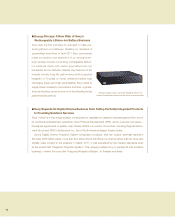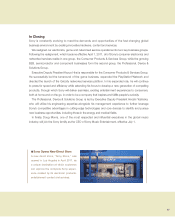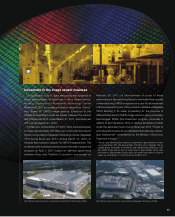Sony 2011 Annual Report Download - page 26
Download and view the complete annual report
Please find page 26 of the 2011 Sony annual report below. You can navigate through the pages in the report by either clicking on the pages listed below, or by using the keyword search tool below to find specific information within the annual report.
■The “Exmor” CMOS image sensor—linchpin of Sony’s
interchangeable lens digital cameras
While the “Exmor R” back-illuminated CMOS image sensor, which realizes both high
sensitivity and miniaturization, is deployed in compact digital cameras and mobile phones,
for interchangeable lens digital cameras a large-format image sensor (an APS-C-sized
sensor or full-frame sensor) that provides high picture quality and advanced potential for
creativity is absolutely essential. To meet such high demands, Sony developed the “Exmor”
CMOS image sensor in-house, which realizes high-resolution images with fine detail and
rich tonal gradation.
The “Exmor” utilizes on-chip column A/D conversion and dual noise reduction
processing whereby noise reduction is applied both before and after analog/digital
conversion. By eliminating noise at the initial stage of light capture and conversion to
electrical signals, the “Exmor” realizes outstanding image quality and suppresses noise
to the greatest extent possible, even in low-light situations. “Exmor”’s capabilities were
first demonstrated when it was deployed in the α700, a mid-range interchangeable lens
DSLR camera launched in 2007. A full-frame “Exmor” image sensor was subsequently
used in the α900, released in 2008. In recent years, Sony has developed the “Exmor”
APS HD CMOS image sensor, optimized for Full HD movies in response to increasing
demand for Full HD video capabilities in single-lens digital cameras. The “Exmor” image
sensor is also featured in the α55 and α33—which realize high-speed continuous
shooting, thanks to Sony’s groundbreaking Translucent Mirror Technology*—and in the
NEX-5 and NEX-3 compact interchangeable lens digital cameras, as well as in the NEX-
VG10, the world’s first interchangeable lens HD video camera, launched in 2010, and
remains at the cutting edge of image quality. Going forward, the “Exmor” CMOS image
sensor will continue to play a key role in driving evolution in the growing interchangeable
lens digital camera market.
24
Interchangeable lens digital camera “α55”
* Translucent Mirror Technology uses a translucent mirror to continuously direct light passing through the
lens to both the CMOS image sensor and the phase detection AF sensor simultaneously. This enables
continuous fast, high-precision phase-detection AF shooting and continuous focusing on the shooting
target.
























